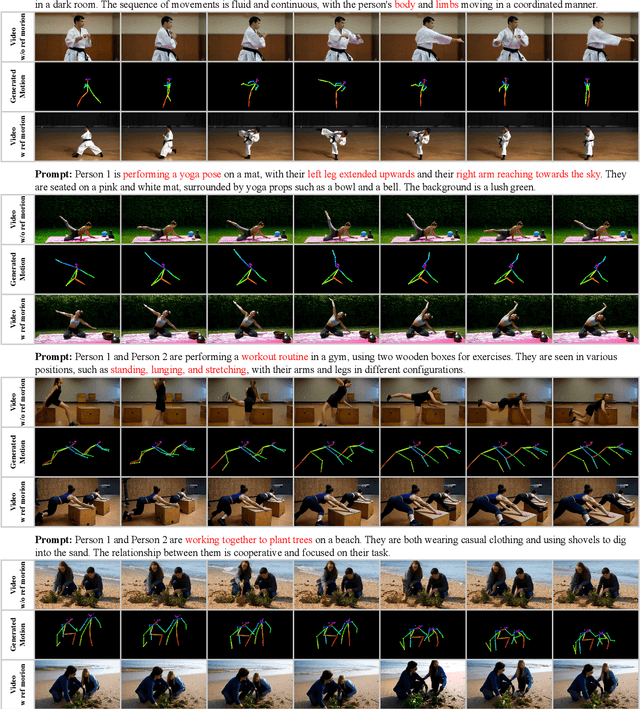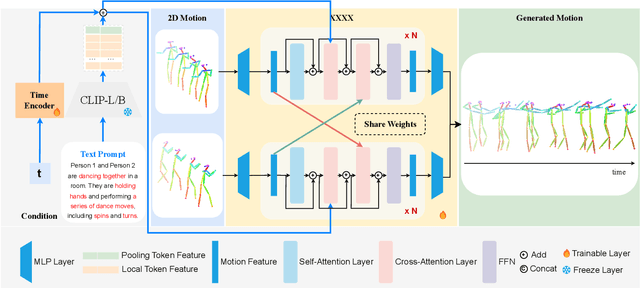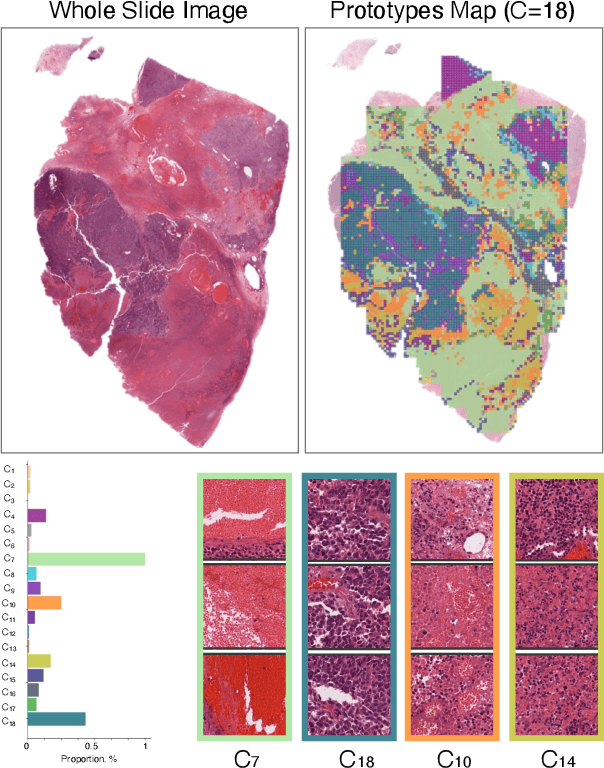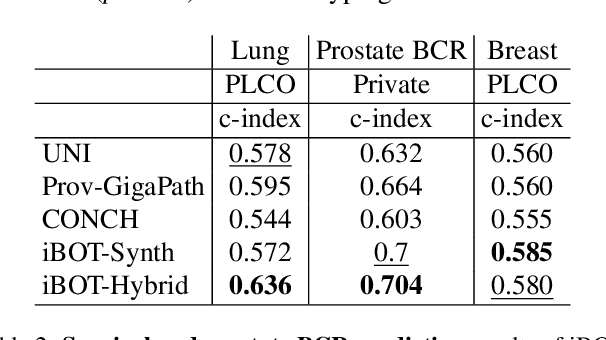Zichen Wang
Zhejiang University, Hangzhou, China
DreamSwapV: Mask-guided Subject Swapping for Any Customized Video Editing
Aug 20, 2025Abstract:With the rapid progress of video generation, demand for customized video editing is surging, where subject swapping constitutes a key component yet remains under-explored. Prevailing swapping approaches either specialize in narrow domains--such as human-body animation or hand-object interaction--or rely on some indirect editing paradigm or ambiguous text prompts that compromise final fidelity. In this paper, we propose DreamSwapV, a mask-guided, subject-agnostic, end-to-end framework that swaps any subject in any video for customization with a user-specified mask and reference image. To inject fine-grained guidance, we introduce multiple conditions and a dedicated condition fusion module that integrates them efficiently. In addition, an adaptive mask strategy is designed to accommodate subjects of varying scales and attributes, further improving interactions between the swapped subject and its surrounding context. Through our elaborate two-phase dataset construction and training scheme, our DreamSwapV outperforms existing methods, as validated by comprehensive experiments on VBench indicators and our first introduced DreamSwapV-Benchmark.
RTR-GS: 3D Gaussian Splatting for Inverse Rendering with Radiance Transfer and Reflection
Jul 10, 2025Abstract:3D Gaussian Splatting (3DGS) has demonstrated impressive capabilities in novel view synthesis. However, rendering reflective objects remains a significant challenge, particularly in inverse rendering and relighting. We introduce RTR-GS, a novel inverse rendering framework capable of robustly rendering objects with arbitrary reflectance properties, decomposing BRDF and lighting, and delivering credible relighting results. Given a collection of multi-view images, our method effectively recovers geometric structure through a hybrid rendering model that combines forward rendering for radiance transfer with deferred rendering for reflections. This approach successfully separates high-frequency and low-frequency appearances, mitigating floating artifacts caused by spherical harmonic overfitting when handling high-frequency details. We further refine BRDF and lighting decomposition using an additional physically-based deferred rendering branch. Experimental results show that our method enhances novel view synthesis, normal estimation, decomposition, and relighting while maintaining efficient training inference process.
Toward Rich Video Human-Motion2D Generation
Jun 17, 2025



Abstract:Generating realistic and controllable human motions, particularly those involving rich multi-character interactions, remains a significant challenge due to data scarcity and the complexities of modeling inter-personal dynamics. To address these limitations, we first introduce a new large-scale rich video human motion 2D dataset (Motion2D-Video-150K) comprising 150,000 video sequences. Motion2D-Video-150K features a balanced distribution of diverse single-character and, crucially, double-character interactive actions, each paired with detailed textual descriptions. Building upon this dataset, we propose a novel diffusion-based rich video human motion2D generation (RVHM2D) model. RVHM2D incorporates an enhanced textual conditioning mechanism utilizing either dual text encoders (CLIP-L/B) or T5-XXL with both global and local features. We devise a two-stage training strategy: the model is first trained with a standard diffusion objective, and then fine-tuned using reinforcement learning with an FID-based reward to further enhance motion realism and text alignment. Extensive experiments demonstrate that RVHM2D achieves leading performance on the Motion2D-Video-150K benchmark in generating both single and interactive double-character scenarios.
VideoPDE: Unified Generative PDE Solving via Video Inpainting Diffusion Models
Jun 16, 2025Abstract:We present a unified framework for solving partial differential equations (PDEs) using video-inpainting diffusion transformer models. Unlike existing methods that devise specialized strategies for either forward or inverse problems under full or partial observation, our approach unifies these tasks under a single, flexible generative framework. Specifically, we recast PDE-solving as a generalized inpainting problem, e.g., treating forward prediction as inferring missing spatiotemporal information of future states from initial conditions. To this end, we design a transformer-based architecture that conditions on arbitrary patterns of known data to infer missing values across time and space. Our method proposes pixel-space video diffusion models for fine-grained, high-fidelity inpainting and conditioning, while enhancing computational efficiency through hierarchical modeling. Extensive experiments show that our video inpainting-based diffusion model offers an accurate and versatile solution across a wide range of PDEs and problem setups, outperforming state-of-the-art baselines.
Provably Efficient Algorithm for Best Scoring Rule Identification in Online Principal-Agent Information Acquisition
May 23, 2025Abstract:We investigate the problem of identifying the optimal scoring rule within the principal-agent framework for online information acquisition problem. We focus on the principal's perspective, seeking to determine the desired scoring rule through interactions with the agent. To address this challenge, we propose two algorithms: OIAFC and OIAFB, tailored for fixed confidence and fixed budget settings, respectively. Our theoretical analysis demonstrates that OIAFC can extract the desired $(\epsilon, \delta)$-scoring rule with a efficient instance-dependent sample complexity or an instance-independent sample complexity. Our analysis also shows that OIAFB matches the instance-independent performance bound of OIAFC, while both algorithms share the same complexity across fixed confidence and fixed budget settings.
Prototype-Guided Diffusion for Digital Pathology: Achieving Foundation Model Performance with Minimal Clinical Data
Apr 15, 2025



Abstract:Foundation models in digital pathology use massive datasets to learn useful compact feature representations of complex histology images. However, there is limited transparency into what drives the correlation between dataset size and performance, raising the question of whether simply adding more data to increase performance is always necessary. In this study, we propose a prototype-guided diffusion model to generate high-fidelity synthetic pathology data at scale, enabling large-scale self-supervised learning and reducing reliance on real patient samples while preserving downstream performance. Using guidance from histological prototypes during sampling, our approach ensures biologically and diagnostically meaningful variations in the generated data. We demonstrate that self-supervised features trained on our synthetic dataset achieve competitive performance despite using ~60x-760x less data than models trained on large real-world datasets. Notably, models trained using our synthetic data showed statistically comparable or better performance across multiple evaluation metrics and tasks, even when compared to models trained on orders of magnitude larger datasets. Our hybrid approach, combining synthetic and real data, further enhanced performance, achieving top results in several evaluations. These findings underscore the potential of generative AI to create compelling training data for digital pathology, significantly reducing the reliance on extensive clinical datasets and highlighting the efficiency of our approach.
Zero-shot Medical Event Prediction Using a Generative Pre-trained Transformer on Electronic Health Records
Mar 07, 2025Abstract:Longitudinal data in electronic health records (EHRs) represent an individual`s clinical history through a sequence of codified concepts, including diagnoses, procedures, medications, and laboratory tests. Foundational models, such as generative pre-trained transformers (GPT), can leverage this data to predict future events. While fine-tuning of these models enhances task-specific performance, it is costly, complex, and unsustainable for every target. We show that a foundation model trained on EHRs can perform predictive tasks in a zero-shot manner, eliminating the need for fine-tuning. This study presents the first comprehensive analysis of zero-shot forecasting with GPT-based foundational models in EHRs, introducing a novel pipeline that formulates medical concept prediction as a generative modeling task. Unlike supervised approaches requiring extensive labeled data, our method enables the model to forecast a next medical event purely from a pretraining knowledge. We evaluate performance across multiple time horizons and clinical categories, demonstrating model`s ability to capture latent temporal dependencies and complex patient trajectories without task supervision. Model performance for predicting the next medical concept was evaluated using precision and recall metrics, achieving an average top1 precision of 0.614 and recall of 0.524. For 12 major diagnostic conditions, the model demonstrated strong zero-shot performance, achieving high true positive rates while maintaining low false positives. We demonstrate the power of a foundational EHR GPT model in capturing diverse phenotypes and enabling robust, zero-shot forecasting of clinical outcomes. This capability enhances the versatility of predictive healthcare models and reduces the need for task-specific training, enabling more scalable applications in clinical settings.
C2F-TP: A Coarse-to-Fine Denoising Framework for Uncertainty-Aware Trajectory Prediction
Dec 17, 2024Abstract:Accurately predicting the trajectory of vehicles is critically important for ensuring safety and reliability in autonomous driving. Although considerable research efforts have been made recently, the inherent trajectory uncertainty caused by various factors including the dynamic driving intends and the diverse driving scenarios still poses significant challenges to accurate trajectory prediction. To address this issue, we propose C2F-TP, a coarse-to-fine denoising framework for uncertainty-aware vehicle trajectory prediction. C2F-TP features an innovative two-stage coarse-to-fine prediction process. Specifically, in the spatial-temporal interaction stage, we propose a spatial-temporal interaction module to capture the inter-vehicle interactions and learn a multimodal trajectory distribution, from which a certain number of noisy trajectories are sampled. Next, in the trajectory refinement stage, we design a conditional denoising model to reduce the uncertainty of the sampled trajectories through a step-wise denoising operation. Extensive experiments are conducted on two real datasets NGSIM and highD that are widely adopted in trajectory prediction. The result demonstrates the effectiveness of our proposal.
Online Experimental Design With Estimation-Regret Trade-off Under Network Interference
Dec 04, 2024Abstract:Network interference has garnered significant interest in the field of causal inference. It reflects diverse sociological behaviors, wherein the treatment assigned to one individual within a network may influence the outcome of other individuals, such as their neighbors. To estimate the causal effect, one classical way is to randomly assign experimental candidates into different groups and compare their differences. However, in the context of sequential experiments, such treatment assignment may result in a large regret. In this paper, we develop a unified interference-based online experimental design framework. Compared to existing literature, we expand the definition of arm space by leveraging the statistical concept of exposure mapping. Importantly, we establish the Pareto-optimal trade-off between the estimation accuracy and regret with respect to both time period and arm space, which remains superior to the baseline even in the absence of network interference. We further propose an algorithmic implementation and model generalization.
Underload: Defending against Latency Attacks for Object Detectors on Edge Devices
Dec 03, 2024Abstract:Object detection is a fundamental enabler for many real-time downstream applications such as autonomous driving, augmented reality and supply chain management. However, the algorithmic backbone of neural networks is brittle to imperceptible perturbations in the system inputs, which were generally known as misclassifying attacks. By targeting the real-time processing capability, a new class of latency attacks are reported recently. They exploit new attack surfaces in object detectors by creating a computational bottleneck in the post-processing module, that leads to cascading failure and puts the real-time downstream tasks at risks. In this work, we take an initial attempt to defend against this attack via background-attentive adversarial training that is also cognizant of the underlying hardware capabilities. We first draw system-level connections between latency attack and hardware capacity across heterogeneous GPU devices. Based on the particular adversarial behaviors, we utilize objectness loss as a proxy and build background attention into the adversarial training pipeline, and achieve a reasonable balance between clean and robust accuracy. The extensive experiments demonstrate the defense effectiveness of restoring real-time processing capability from $13$ FPS to $43$ FPS on Jetson Orin NX, with a better trade-off between the clean and robust accuracy.
 Add to Chrome
Add to Chrome Add to Firefox
Add to Firefox Add to Edge
Add to Edge